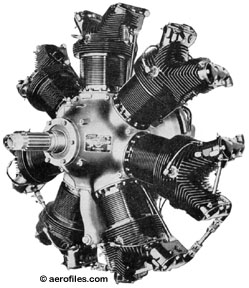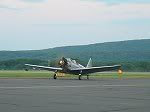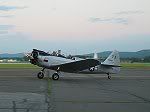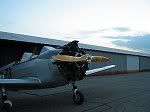Friday, June 17, 2005
Round-Engined Goodness
I was at the airport the other evening, washing bugs off the Yellowbird, when I heard a distinctive sound coming from midfield. It was something between a growl and a rumble and a throb, and it echoed off the nearby hangars until it was difficult to tell exactly where it came from . I knew at once what it was. It was a sound that once filled the skies of America, particularly in the south and west, but which is rarely heard these days. It was the sound of a radial engined aircraft. Most air-cooled piston engines in use today are of the horizontal-opposed type, like Yellowbird's Lycoming O-360, but radial engines once powered a large percentage of propeller driven aircraft. Their reputation for durability and low power to weight ratios (compared to liquid-cooled engines) made them popular with aircraft designers from the early days of aviation up until the 1950's and 1960's, when the increased complexity of high-powered radial engines encouraged their replacement by newly developed turboprop engines capable of even greater power at lower weights. Today, very few airplanes still fly with radial engines, and most of those are rarely seen outside of air shows. If you're lucky, you might catch one in the pattern on a quiet summer evening, keeping the rust and cobwebs away. The other evening, I got lucky.
Most air-cooled piston engines in use today are of the horizontal-opposed type, like Yellowbird's Lycoming O-360, but radial engines once powered a large percentage of propeller driven aircraft. Their reputation for durability and low power to weight ratios (compared to liquid-cooled engines) made them popular with aircraft designers from the early days of aviation up until the 1950's and 1960's, when the increased complexity of high-powered radial engines encouraged their replacement by newly developed turboprop engines capable of even greater power at lower weights. Today, very few airplanes still fly with radial engines, and most of those are rarely seen outside of air shows. If you're lucky, you might catch one in the pattern on a quiet summer evening, keeping the rust and cobwebs away. The other evening, I got lucky. What I heard, and then saw directly overhead on a left downwind for 33, was a Fairchild PT-23A, the radial engine version of the PT-19 trainer from World War II. This PT-23 is locally based, and I've seen it in the skies before, but never up close. For a few moments, I reveled in the unique music of its seven-cylindered Continental engine as it trundled overhead. Then I cursed myself for leaving the camera at home. I rushed home to get it, hoping to catch him in action before he came back down, but as I pulled into the FBO parking lot, I saw that the evening's airshow was coming to a close. I settled for finding an advantageous spot on the ramp to watch him as he taxied back to his hangar.
What I heard, and then saw directly overhead on a left downwind for 33, was a Fairchild PT-23A, the radial engine version of the PT-19 trainer from World War II. This PT-23 is locally based, and I've seen it in the skies before, but never up close. For a few moments, I reveled in the unique music of its seven-cylindered Continental engine as it trundled overhead. Then I cursed myself for leaving the camera at home. I rushed home to get it, hoping to catch him in action before he came back down, but as I pulled into the FBO parking lot, I saw that the evening's airshow was coming to a close. I settled for finding an advantageous spot on the ramp to watch him as he taxied back to his hangar. As he rolled past, he cut the engine and coasted in with the prop stopped. Taildraggers are said to be tricky to handle on the ground, but I was treated to a fine display of parking as he deftly applied the right brake and spun around to stop directly in front of the hangar door.
As he rolled past, he cut the engine and coasted in with the prop stopped. Taildraggers are said to be tricky to handle on the ground, but I was treated to a fine display of parking as he deftly applied the right brake and spun around to stop directly in front of the hangar door. As the crew packed up for the night, I took some time to chat with them and examine the old girl. She's been beautifully restored in authentic wartime markings. Every square inch of her wooden wings and fabric covering spoke of careful attention to detail. It was a treat to see such a rare airplane so well cared for. I knew the pilot by reputation, having some common acquaintances, but I had never met him in person before. He was happy to share with me as I asked any questions that came to mind, and I was delighted at the opportunity to meet him and his airplane.
As the crew packed up for the night, I took some time to chat with them and examine the old girl. She's been beautifully restored in authentic wartime markings. Every square inch of her wooden wings and fabric covering spoke of careful attention to detail. It was a treat to see such a rare airplane so well cared for. I knew the pilot by reputation, having some common acquaintances, but I had never met him in person before. He was happy to share with me as I asked any questions that came to mind, and I was delighted at the opportunity to meet him and his airplane. Here's 668 cubic inches of pure radial goodness. Surprisingly, she only has 40 more horsepower than Yellowbird does, but she puts it out with a glorious sound that gives the impression of much more power. Oh, to live in the age of round engines and cloth helmets! For now, it's good to live next door to an airport where such things can still be found. This round engine flies frequently, the pilot has my phone number and an open invitation has been extended - I may get even luckier...
Here's 668 cubic inches of pure radial goodness. Surprisingly, she only has 40 more horsepower than Yellowbird does, but she puts it out with a glorious sound that gives the impression of much more power. Oh, to live in the age of round engines and cloth helmets! For now, it's good to live next door to an airport where such things can still be found. This round engine flies frequently, the pilot has my phone number and an open invitation has been extended - I may get even luckier...Update:
If you like airplane engines, round, square, or triangular, you might want to visit the Aircraft Engine Historical Society. Their website has many cubic inches of fascinating information on airplane engines, including historical and engineering articles, photographs, and even sound recordings of these amazing engines.
(The W-670 photo is hosted on AeroFiles.com.)
